
Testing the Milk
In 1890, agricultural chemist Stephen Babcock tackled one of the biggest obstacles confronting the nascent Wisconsin dairy industry: measuring the quality of milk. Babcock’s butterfat tester was a cheap, fast and foolproof method of preventing milk from being watered down. The test kept the industry honest, hastened the introduction of science into dairy processing, and helped position the new College of Agriculture as a player in a business that was becoming Wisconsin's signature industry.

Understanding the American Frontier
In 1893, historian Frederick Jackson Turner attributed the perseverance, individualism, pragmatism and grass-roots governance of the American character to the qualities necessary to survive on the frontier. Although Turner's theory is now debated, it was one of history’s most influential descriptions of the uniqueness of the growing nation.
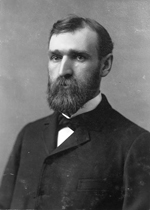
A University Without Boundaries
One hundred years ago, UW president Charles Van Hise declared that he would “never be content until the beneficent influence of the university reaches every family in the state.” The University’s sphere of influence has expanded worldwide, but the “Wisconsin Idea” remains a beacon in education, policy and technology transfer.
[2012 ACS President Bassam Z. Shakhashiri is the first holder of the William T. Evjue Distinguished Chair for the Wisconsin Idea, a position he has held since 2001.]

Vitamins A & B
In 1914, biochemist Elmer (E.V.) McCollum identified the first vitamin, Vitamin A, during rodent research, and two years later, he and Margaret Davis identified Vitamin B.
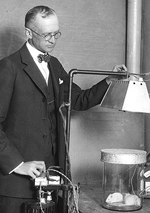
Vitamin D
In 1924, Harry Steenbock discovered that ultraviolet light stimulates the formation of Vitamin D, laying the foundation for Vitamin D supplementation of food and eliminating the bone disease rickets. Steenbock played a major role in forming the Wisconsin Alumni Research Foundation, which held his patents and later handled almost 2,000 others from UW-Madison. As UW-Madison researchers continue to explore drugs for osteoporosis and kidney disease, Vitamin D patents remain among the most profitable at WARF.
Read about John Steuart Curry's mural "The Social Benefits of Biochemical Research," housed in the Biochemistry building, depicting the benefits of this discovery.

Poisoning Rats, Healing Patients
In 1941 biochemist Karl Paul Link discovered a powerful anti-clotting agent that was causing cows to bleed to death. Dicumarol became the active ingredient in Warfarin, widely used for decades to kill rodents. Link then discovered Coumadin, a “blood-thinning” pharmaceutical which is still ubiquitous for preventing clots. Conservatively estimated, the discoveries saved thousands of lives.
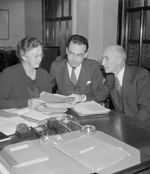
Social Policy—In the Vanguard
The 1935 Social Security Act and such innovations as unemployment compensation and anti-trust policy were a direct outgrowth of policies propounded by UW economists John Witte, John Commons and Arthur Altmeyer, who focused on how government could help the welfare of millions of Americans.
At left: Arthur Altmeyer (center) presiding over an early meeting of the Social Security Board, 1937.

The Role of Mother
In the 1930s, psychologist Harry Harlow began studying the social life of monkeys, eventually proving beyond question that primates cannot be physically or emotionally healthy without a strong, physical attachment to their mothers, which Harlow called “love.” If this sounds obvious, at the time, psychological science was dominated by the psychoanalytic theories of Sigmund Freud on one side and the behaviorist B.F. Skinner on the other, leaving little room for what Harlow called “common sense.”
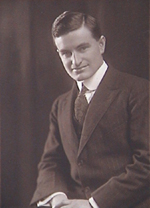
A Friend of the Sun
In the 1950s, long before “alternative energy” was coined, chemist Farrington Daniels became an advocate of solar energy. As director of the Solar Energy Laboratory, he explored the sun’s use for heat, electricity, cooking and industrial processes, and early on recognized that solar energy could play a major role in developing countries.
[Farrington Daniels was ACS president in 1953.]

Weather Satellite Leader
In 1959, Verner Suomi became the first American to conduct weather research from space, when he placed an instrument aboard an early satellite. Suomi later invented a satellite camera capable of imaging Earth that became the foundation for a more holistic and precise view of our planet’s weather. From this starting point, UW-Madison remains a world leader in satellite meteorology.
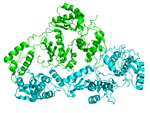
An Enzyme With Impact
In 1970, Howard Temin identified an enzyme that broke the conventional “DNA makes RNA” wisdom of genetics. He showed that the enzyme reverse transcriptase allowed RNA to change DNA. Reverse transcriptase is the hallmark of retroviruses, the family that includes HIV. The discovery earned Temin a Nobel Prize in 1975.
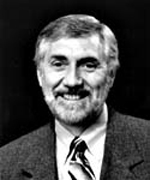
The Image of Medicine
Starting in 1973, medical physicist Charles Mistretta explored new ways to make images of blood vessels, and invented digital subtraction angiography, a now-standard technique for looking at arterial health. In 1985, Paul Moran helped invent a method for watching blood flow using the new technology of magnetic resonance imaging. UW researchers have also contributed breakthroughs in osteoporosis scanning and CT imaging technology.

Stem Cells
Twice, James Thomson turned the world of biology upside down with discoveries related to pluripotent stem cells—cells that can give rise to any cell in the body. In 1998, Thomson was the first in the world to culture human embryonic stem cells, and in 2007, he and a Japanese researcher independently isolated a related human cell without using embryos. Although biologists hope that one or both of these cells will cure disease by replacing damaged cells, the cells have already become a mainstay in medical and biological research.
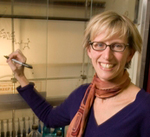
Chemistry Meets Biology
Laura Kiessling works at the interface between chemistry and biology, using chemical “tools” to create biologically active molecules that can mimic or alter natural interactions between living cells. When attached to the surface of a cell, Kiessling's synthetic molecules can prod the cell to grow, die or move, and thus can be used for studying development, cancer and death. Kiessling is using designer molecules to grow and perhaps control pluripotent stem cells that can develop into heart, liver, muscle and brain tissue.
[Laura Kiessling is the editor-in-chief of the ACS Journal of Chemical Biology, and received the ACS Francis P. Garvan-John M. Olin Medal in 2007.]
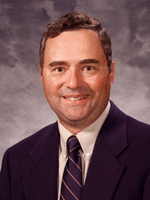
Engineering Fuel
Chemical engineer James Dumesic is on a quest to make biofuels and common industrial chemicals from biomass. Starting from plant sugars and inedible components called lignocelluloses, he's crafted components of diesel fuel, jet fuel and gasoline by clever manipulations of catalysts; some of his processes are approaching industrial production.
[James Dumesic is the recipient of the 2007 ACS Gabor A. Somorjai Award for Creative Research in Catalysis, and the 2012 ACS George A. Olah Award in Hydrocarbon or Petroleum Chemistry.]

The Chemistry of Microbes
Helen Blackwell has developed arrays used for rapid-fire testing of new compounds to battle bacteria, especially the resistant ones that are causing such concern among doctors and public health officials. Blackwell is also exploring ways to interrupt the “quorum sensing” process that bacteria use to count their numbers and turn pathogenic after they have become numerous enough to overwhelm the host.

Chemistry in the Water
Steve Carpenter, the 2011 recipient of the Stockholm Water Prize, has spent his career investigating the ecology and chemistry of fresh water, and helped pioneer “whole-lake experiments” that explored the effects of different management tactics. Carpenter has looked at how invasive species, use of fertilizer, and conservation policies affect the status of the world’s most important liquid—fresh water.
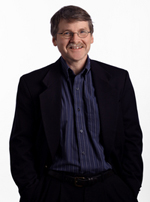
Chemistry at the Surface
Robert Hamers has explored nanotechnology—chemistry and structure at the smallest scale, and has, for example, used bacteria as sensors in an experiment that could produce biological weapons detectors—among many other purposes. Instead of laboriously manipulating nanowires, Hamers wants the bacteria, under close control, to do the heavy lifting. Hamers has also been noted for insights into the chemical and photochemical reactivity of surfaces, and creating practical, functional surfaces with high selectivity and stability.
[Robert Hamers is the recipient of the 2012 ACS Award in Colloid and Surface Chemistry, and the 2005 ACS Arthur W. Adamson Award for Distinguished Service in the Advancement of Surface Chemistry.]
and the University of Wisconsin-Madison Communications Office,
and Cayce Osborne, Wisconsin Initiative for Science Literacy.